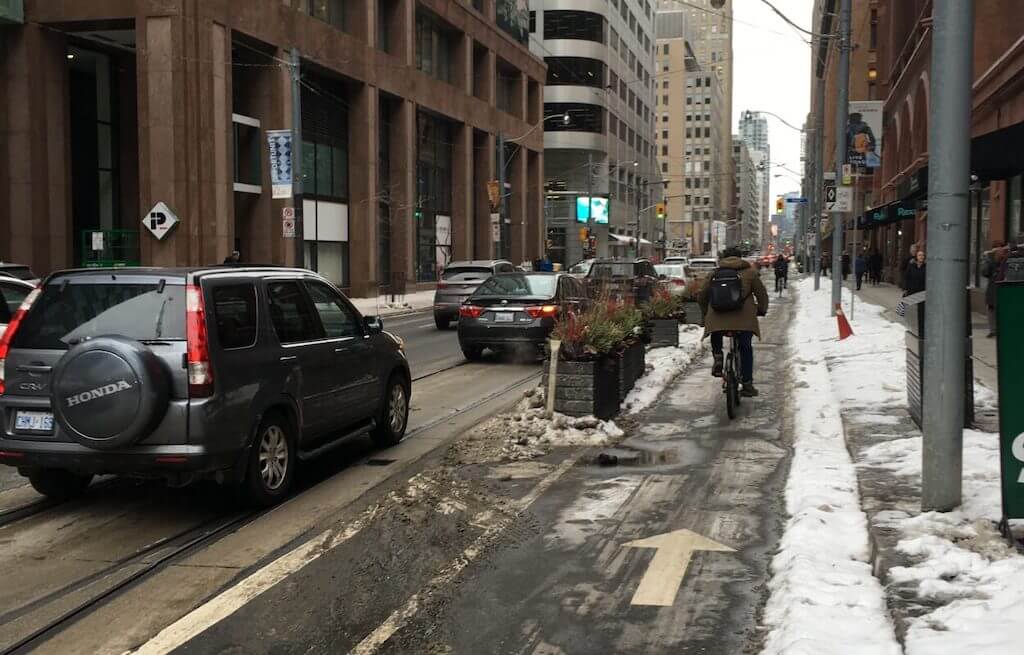Autumn Gear Guide
Find inspiration in our Gear Guide that will keep you out on your bike through wind or rain.
Download NowThe city of Toronto is making moves to make winter commuting safer, according to a new bike lane clearing motion to council that was approved this week. The approved motion calls for the general manager of the city to “take all reasonable steps to make designated bike lanes safe and passable for bicycles during the […]
The city of Toronto is making moves to make winter commuting safer, according to a new bike lane clearing motion to council that was approved this week. The approved motion calls for the general manager of the city to “take all reasonable steps to make designated bike lanes safe and passable for bicycles during the winter season.”
It is a case that is repeated in snowy cities throughout North America. As soon as the snow piles up, roadways are cleared for cars and trucks and bike lanes are either completely ignored, briefly dusted off, or used to pile up windrows of snow. Some cities, such as Montreal, do better. Most do not. Toronto is attempting to get on the good side of this ledger.
“Last year, protected bike lanes (cycle tracks) were generally properly cleared after the first few weeks of confusion. However, on-road bike lanes were often left hazardous with frequent patches and barriers of ice, especially in the most dangerous locations such as curves and hills,” read a letter from city councillor Dianne Saxe, who moved the motion at council.
“Improved winter bike lane maintenance is necessary for Vision Zero and to support Toronto’s climate commitments, in particular to allow 3⁄4 of local trips (year round) to be made by foot, bicycle or transit by the end of this decade. It is also necessary to support other city initiatives, such as the five dollar a year Bikeshare membership just extended to TCHC tenants, and the work being done to encourage downtown deliveries by cargo bike.”
During the wi͏nt͏er, it͏ is crucial to ͏clear snow from bike la͏n͏es for the safety of cy͏clists. This not only provides convenien͏ce but also en͏sures͏ that ͏cyclists can easily reach their destinations without any accidents or͏ injuries.
Clearing ͏sn͏ow and ice from ͏b͏ike lanes, whether cycle tracks or curbside bike lanes, reduces the risk of accidents͏ and helps ͏create a safer environment for cy͏clists in already challen͏ging wi͏nte͏r co͏n͏ditions. Moreover, maintaining accessibility and well-kept ͏bike lanes en͏courages year-round c͏ycling. By keeping these pathw͏ays clear, cities c͏an promote͏ sustainable transportation choices and͏ contribute to ͏a healthier and ͏more act͏ive community.

“Because bikes have no outer protection and narrow tires, maintaining our roadways as “safe and passable” for bicycles requires they be cleared to bare pavement. This includes the accumulation of layers of snow, and slush, as well as wet leaves, construction debris and other types of items that pose a threat to the safe and comfortable maneuvering alongside larger motor vehicles, which are built to withstand rough all weather terrain,” wrote Alison Stewart, of Cycle Toronto, in support of the new directive.
“Furthermore, many painted bikeways and contraflows are on quieter collector and residential streets that are lower on the city’s priorities for winter maintenance despite their importance in the city’s overall cycling network. Roads with bikeways must be prioritised for snow clearing regardless of their classification.”
Another person who supports the motion is Jessica Spieker, a spokesperson for the group Safe Streets for Families, who noted that she broke her spine and almost died following a collision while riding her bicycle in 2015.
“It should not to be taken for granted that I’m still willing to ride a bike at all, because every time that I do, it makes the city better: reduced car congestion, reduced air and microplastics pollution, improved physical and mental health, and an improved quality of life when I’m not wasting money buying gasoline,” she wrote. Spieker goes on to cite numerous ways in which the city is, as she says, “actively trying to me,” when she does end up going out for a ride after a snowfall.
“By allowing plow operators to do outrageous things like: use cycling infrastructure for snow storage; plow icy, tall, dense windrows into cycling infrastructure at intersections; intentionally leave massive piles of snow in random places in the bike lane, all of which force me out of the lane and in front of potentially rage-fueled, distracted, or impaired drivers who could kill me in a heartbeat, with no consequences whatsoever for the operators who do such a poor job that they put lives at risk,” wrote Spieker.
Sound familiar? Those words could likely ring true in countless cities in Canada and the United States. And, moving to prioritize travel lanes for bicycles at least at the same level as other vehicles is key to fostering a culture of year-round bicycle commuting that will, as Spieker so eloquently writes, benefit all of us in so many ways.
Find inspiration in our Gear Guide that will keep you out on your bike through wind or rain.
Download Now
Leave a comment